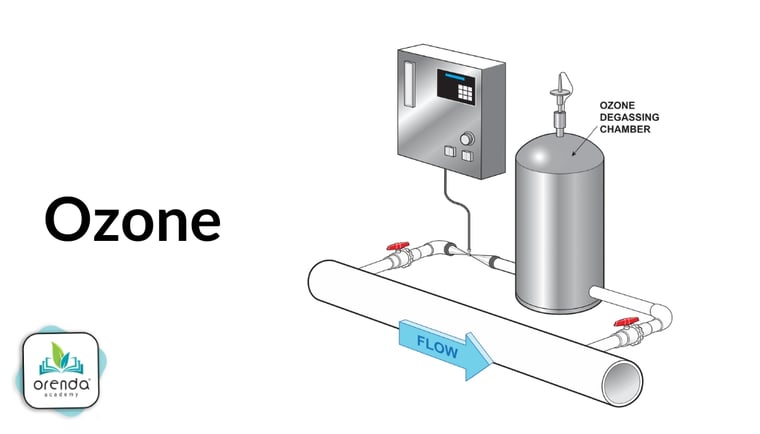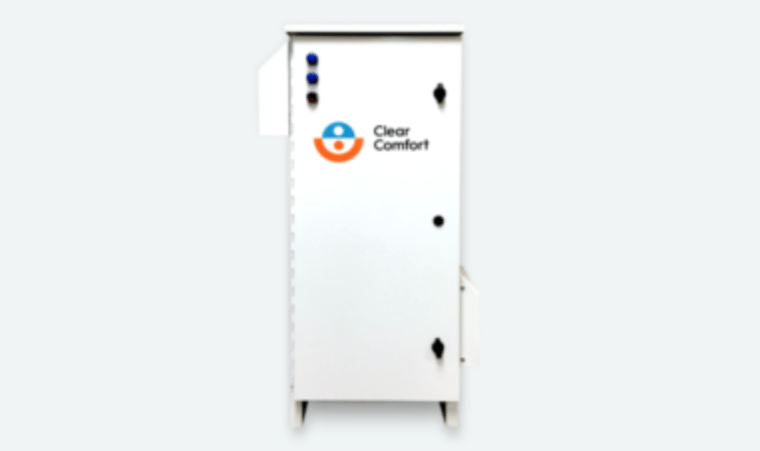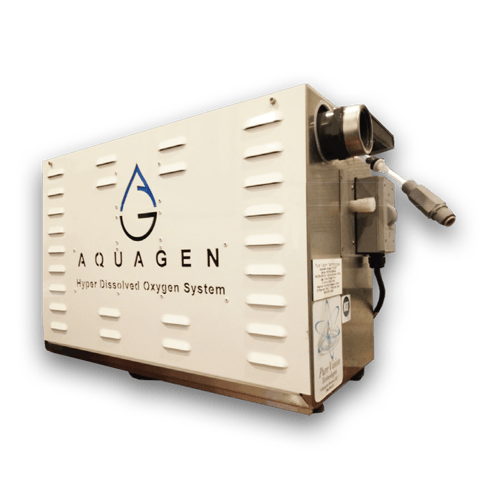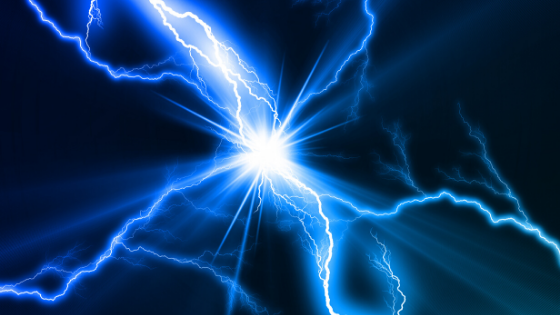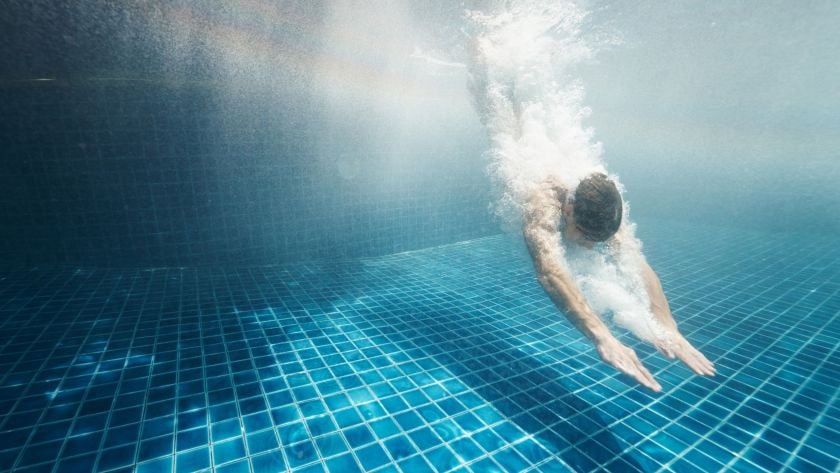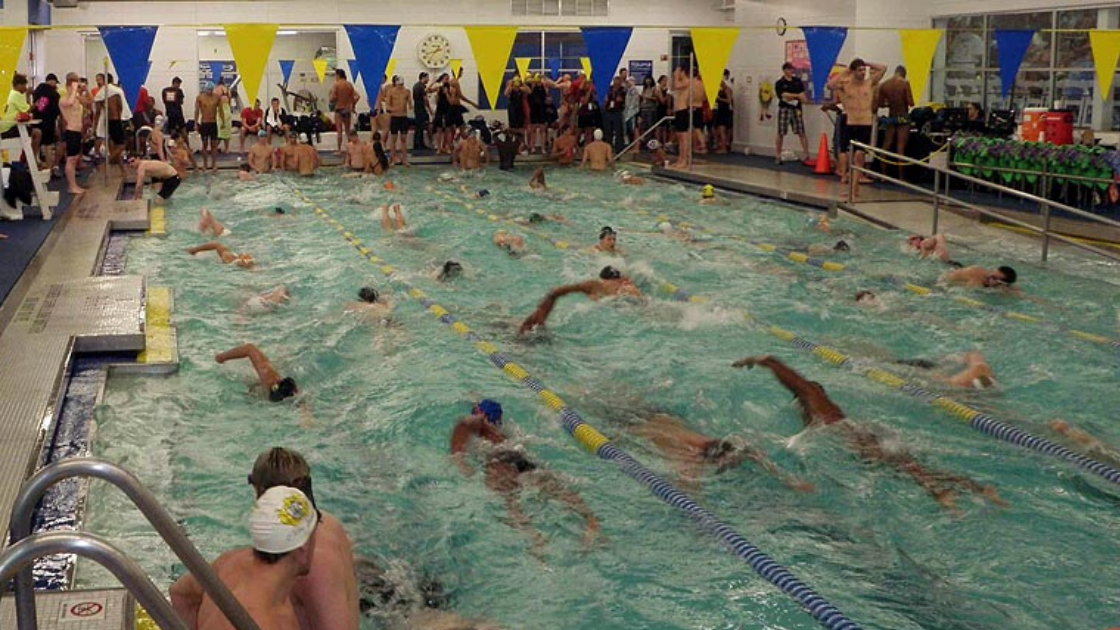Comparing Secondary Disinfection Systems for Swimming Pools
We are often asked for our opinion about UV and Ozone systems, and to compare them. The problem is, it's not an apples-to-apples comparison. So this article is our comparison of secondary disinfection and oxidation systems, and we include two other types of secondary systems: AOP and HDO.
Covered in this article:
- What are secondary disinfection and oxidation systems?
-
- The importance of NSF-50 Certification
- Ultraviolet (UV)
- Ozone (O3)
- Advanced Oxidation Process (AOP)
- Hyper-dissolved Oxygen (HDO)
-
- Conclusion
What are secondary disinfection and oxidation systems?
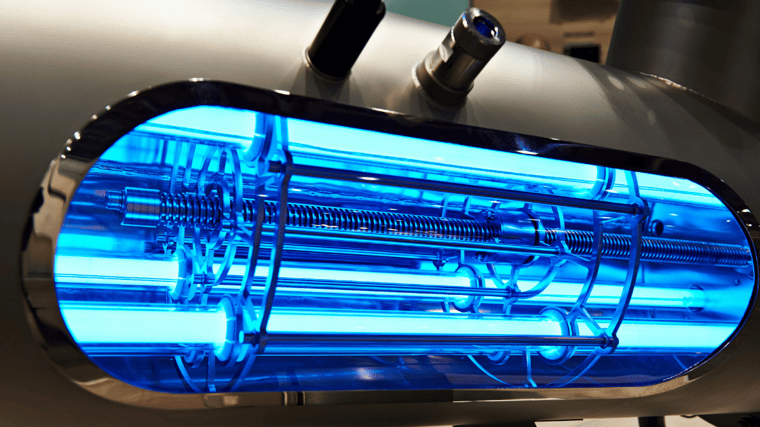
A secondary system is a piece of equipment that chemically treats water to supplement a primary sanitizer (usually chlorine). These systems offer added sanitizing power or oxidation strength and are point-of-contact systems (with one exception) that treat water as it passes by. These systems do not replace the need for a primary sanitizer like chlorine or bromine. They only assist in the war against living and nonliving contamination in swimming pools.
Related: Water Chemistry Resources
The importance of NSF-50 Certification
Before getting into our list, we need to cover two important types of third-party validation and certification. First is an EPA Registration. There is a federal law called FIFRA that requires any chemical or system that claims to kill something (disinfection, algaecide, etc.) to be EPA Registered. There must be an EPA Registration number on the product. It is required by federal law. Just look at your household cleaning sprays, and you will find an EPA registration number if the product claims to kill "99.9% of germs!".
The second certification is NSF/ANSI Standard 50. Directly from NSF International's website:
If you manufacture equipment, components, or chemicals used in pools, spas, splash pads, or other aquatic venues in North America, your products are required to comply with NSF/ANSI 50: Equipment for Swimming Pools, Spas, Hot Tubs and Other Recreational Water Facilities by most state agencies. Developed by a team of scientists, industry experts, and key industry stakeholders, NSF/ANSI 50 sets health effects criteria, operational safety, and performance verification for many recreational water products.
Pool chemicals should be NSF-50 Certified as well, but only one pool chemical manufacturer we know of has every product NSF-50 certified at this time.
Not every system mentioned here has NSF-50 certification, and of those types of systems that do, not every manufacturer is certified. Also, you should be aware that NSF/ANSI Standard 50 has different levels of certification.1
There are essentially four types of secondary systems for swimming pools, with new technologies emerging each year. As those technologies stand the test of time, we'll update this article if we find them worthwhile to install on commercial pools. Until then, the primary four secondary systems are:
-
- Ultraviolet (UV)
- Ozone (O3)
- Advanced Oxidation Process (AOP)
- Hyper-Dissolved Oxygen (HDO)
Here is a summary chart, comparing the four systems:

Now let's discuss each of the four types of secondary systems for swimming pools.
1. Ultraviolet (UV)
EPA Registered - YES
NSF-50 Certified - YES
Compatible with chlorine? - YES, though it can reduce free chlorine
Compatible with bromine? - NO, due to bromate formation from UV exposure
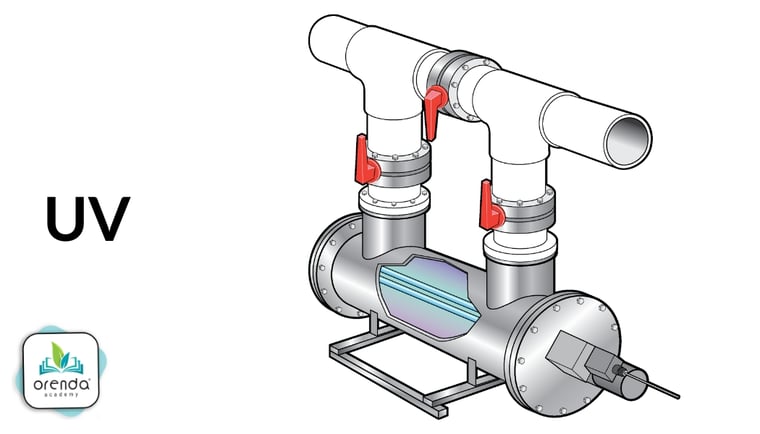
Medium Pressure UV
UV systems are used in many different water treatment systems, from drinking water and irrigation to food processing and recreational pools. UV is a point-of-contact system with an ultraviolet lamp inside a quartz/glass sleeve. As water passes through the chamber, the UV light inactivates and kills living pathogens and destroys combined chlorine. While UV is not an oxidizer, it is a very effective secondary sanitizer, with the ability to inactivate stubborn diseases like Cryptosporidium and Giardia.
So UV does not 'remove' germs. It inactivates, or kills their ability to reproduce by ruining an organism's DNA. UV alone cannot disinfect a swimming pool entirely; it is a point-of-contact supplement to the primary residual sanitizer (usually chlorine).
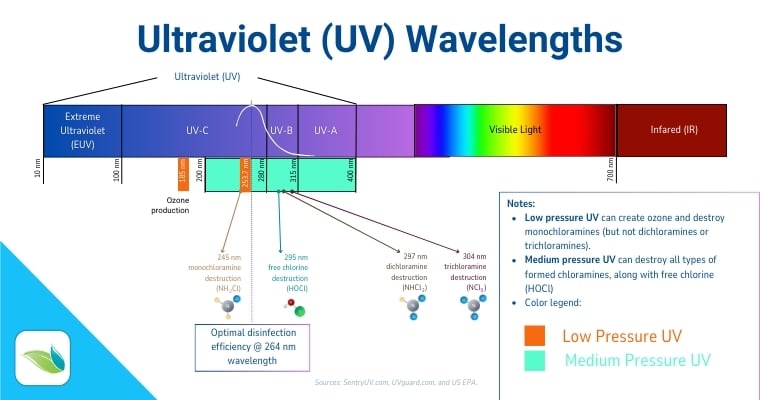
Medium pressure UV can destroy monochloramine and dichloramine, and if it's still in solution, trichloramine too. Unfortunately, medium pressure UV also destroys some free chlorine as well. However, since UV is not an oxidizer, it cannot destroy non-living organics and other oxidants.
Related: Medium Pressure UV vs. Low Pressure UV
The argument could be made that UV's biggest weakness is that it does not oxidize anything. This means nitrogen compounds like urea and ammonia are not reduced by UV, and will eventually form chloramines. Yes, once chloramines are formed, UV can break them down...but that brings us to UV's second biggest weakness. As mentioned earlier, UV is a point-of-contact system, just like Ozone and AOP. It only treats the water as it passes through its chamber. For indoor air quality, UV is said to help, but in our experience, most pools that have hired us to help with air quality problems already had UV systems for years. It helps water quality, but it is limited in its efficacy against airborne pollution because of timing. UV does nothing for chloramines in the air.
2. Ozone (O3)
EPA Registered - YES
NSF-50 Certified - YES
Compatible with chlorine? - YES
Compatible with bromine? - NO, due to bromate formation from ozone
Ozone is one of nature's most powerful oxidizers. When applied correctly on a swimming pool, ozone is an incredible disinfectant too. It can destroy even the most chlorine-resistant parasite, cryptosporidium, in a single pass. Relative to the contact time it takes chlorine to kill crypto, there is no comparison. Ozone destroys just about everything it touches. For sterilization, ozone is used in the food processing industry, data centers, and just about everything in between. It is proven technology that leaves behind oxygen as a byproduct.

Where UV falls short, ozone dominates. For instance, ozone destroys nitrogen compounds like urea and ammonia–the precursors to chloramines. And for good measure, ozone destroys mono-, di- and trichloramines too. It kills germs, viruses, algae, and just about any other type of living contaminant you can think of.
Ozone's big weakness is shared by both UV and AOP: it is a point-of-contact system only. There is little-to-no residual, but some dissolved ozone does make it into the pool with a short lifespan. Ozone is strong enough that it can irritate people's skin, eyes, nose and lungs if it were to get out into the pool in strong enough concentrations. This is why properly-installed ozone systems have de-gassing chambers, also called contact tanks. These chambers allow enough contact time for ozone to disinfect and oxidize, while allowing the expended ozone to rise up in the chamber and escape (rather than flow out into the pool itself).
Since it is a point-of-contact system, ozone–at least in our personal experience–does not make a noticable impact on indoor air quality in pools. The reactions that cause airborne chloramines occur out in the pool, whereas ozone is in the pump room treating water as it passes through.
3. Advanced Oxidation Process (AOP)
EPA Registered - YES
NSF-50 Certified - YES
Compatible with chlorine? - YES
Compatible with bromine? - NO, due to bromate formation from Hydroxyl radicals (•OH)
If you are torn between UV and Ozone for secondary disinfection, how about a system that incorporates both? That's right. AOP utilizes UV-C light and Ozone together to create a new type of oxidizer: a Hydroxyl Radical (•OH). Manufacturers that create Hydroxyl Radical systems say hydroxyls can oxidize and sanitize faster than Ozone.
The UV used in AOP systems is different from low or medium pressure UV, in that a normal UV system has 100% of the circulated water flowing through its chamber for treatment. AOP uses UV-C light to break down ozone into Hydroxyl Radicals, which are then injected into a plumbed bypass loop, which is a smaller volume of water. So the UV and Ozone used actually do not treat 100% of circulated water. Presumably, however, hydroxyl radicals that are injected into the water get pulled back into the main circulation (via a venturi valve), and sanitize in a short amount of time. And, these hydroxyradicals have a short lifespan...they work fast and then they're gone.
All that is to say, while AOP may be an excellent disinfection and oxidation system for water, its primary weakness, just like UV and Ozone, is that it is a point-of-contact system. AOP only treats water as it passes through the plumbing, and does not have a residual that goes out into the main pool. And because of this, its impact on indoor air quality is inherently limited. The other weakness of AOP is cost. These systems may be less money up front to install, but they have expensive components that must be replaced and maintained over time.
The final secondary system is neither a sanitizer or disinfectant, but it is the only system on this list that actually creates a residual...
4. Hyper-Dissolved Oxygen (HDO)
EPA Registered - No, N/A. Manufacturers make no disinfection claims
NSF-50 Certified - YES
Compatible with chlorine? - YES
Compatible with bromine? - YES
Pure oxygen dissolved into water can help accelerate many important chemistries therein. But it is not a secondary disinfectant, and therefore does not meet that criteria that many health departments seek. It is a supplement and betterment to a pool system.
For instance, dissolved oxygen boosts chlorine's ability to oxidize, providing excess oxygen to fuel the process. Excess oxygen also boosts enzyme performance, as enzymes benefit from oxygenation to metabolize non-living organics and oils (bather waste). And hyper-dissolved oxygen (HDO) does not just dissolve oxygen into the water; it dissolves it into solution with bubbles so small they don't even float.
For swimming pools, the only product available on the market at this time claims to be able to put 100 million micro-bubbles of purified oxygen into every milliliter (mL) of water. And the concentration of purified oxygen can be measured and verified with a digital meter.
HDO is not a sanitizer or disinfectant. And compared to AOP or Ozone, purified oxygen is a relatively weak oxidizer. That's not the point of the system, though. The point of HDO is to boost chlorine's performance and efficiency. And if you use enzymes, it dramatically boosts enzyme performance too.
One thing we especially like about HDO is the side benefit (or byproduct, you could say). Eventually these bubbles will be agitated and gas out into the air, which means purified oxygen is introduced to the swimmer's breathing zone. Competitive swimmers will, without a doubt, benefit from pure oxygen displacing airborne chloramines and other DBP pollutants like trihalomethanes in the breathing zone. We have experienced it personally, having swum in multiple pools with HDO systems installed. There is a clear difference.
Conclusion
Each system has its benefits and drawbacks. And they are not mutually exclusive! Many pools utilize multiple systems together, such as UV and HDO, or Ozone and HDO. The objective of all of these systems are to enhance water quality, and they go about it different ways. UV deactivates cells by disrupting DNA so they cannot reproduce; Ozone oxidizes and destroys just about anything it touches, including Cryptosproridium in a single pass; AOP creates the fastest oxidizer, the Hydroxyl Radical (•OH); and HDO creates a residual of purified oxygen that boosts chlorine, enzymes, and off-gasses pure oxygen into the swimmer's breathing zone.
In terms of sanitization, the first three all meet the criteria as as secondary disinfectant. But in terms of improving air quality, in our opinion, Hyper-Dissolved Oxygen is in a league of its own. It should not stand by itself, as it carries no disinfection power, and that's where it falls short.
No matter which secondary system you choose, all of them can help improve water quality. Choose wisely. And if you want our opinion based on the needs of your pool, just ask us.
1 Some NSF-50 certifications confirm the system is physically safe to use; for example, it injects gas into the water the way it is supposed to, or it will not catch on fire spontaneously. Other NSF-50 certifications are for performance claims; like the system kills such-and-such disease in X one pass, or the system destroys monochloramines. This is different from EPA Registration, which by Federal law is required if a product makes any killing claims at all.

 By
By
